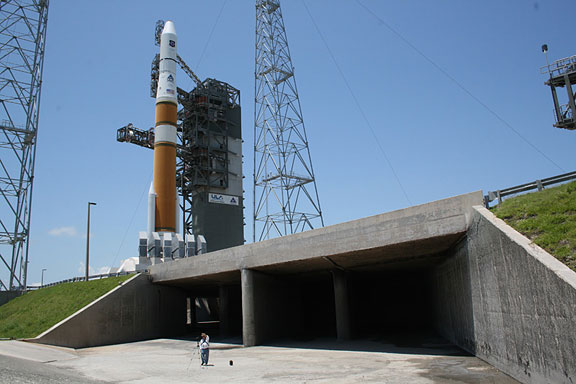By Scott Edmonds, THE CANADIAN PRESS
WINNIPEG - So, you've got
GPS on your smartphone and can tackle the trip to Uncle Charlie's new house in the suburbs with a fresh sense of confidence.
But are you ready for a trip down the Amazon?
"Interesting, I'd love to do that test," laughs Christ Peralta, head of social location services for Nokia.
"That's a real interesting use case. I wouldn't advise it," says a slightly more definitive Ken Kershner, vice-president of software at Research in Motion's subsidiary Dash.
OK, it was just a thought. And perhaps
smartphone GPS isn't ready for the jungles of Brazil, but both men suggest it's perfectly designed for the more urban jungle most cellphone users must deal with every day.
GPS stands for
Global Positioning System. It's a worldwide navigation tool, supplied courtesy of the U.S. military, that relies on 24 satellites that transmit their location and the current time.
Signals arrive at
GPS receivers at slightly different times based on how far away each satellite is from the receiver. With at least four satellite signals, a receiver can then calculate its position. Hand-held
GPS receivers are usually accurate to within 10 to 20 metres.
It's old hat now and in use for commercial navigation, helps hunters find their way in the woods and leads fishermen unerringly back to that
hotspot they found last year. It continues to grow in popularity as the cost of receivers comes down.
Cellphones have had
GPS locators in them since 2005 because the United States decided it wanted to be able to track cellphone location for emergency purposes after Sept. 11, 2001.
While initially the feature just sat there, cellphone manufacturers were quick to make good use of the application. Besides finding out where you are, or where you're going, you can also keep track of your children, post your location to
Facebook or find a lost phone.
Manufacturers are always on the lookout for new ways for customers to use their cellphones and there seem to be few limits on the applications.
Smartphones already make the old '
communicator' that once seemed so slick on "
Star Trek" look like a kid's toy.
"I think the key is to find out what consumers want," says Peralta. "The second step is to make it easy out of the box."
He says that's what Nokia is trying to do with its latest offering for its
smartphones: the preloaded
Ovi mapping system that makes them into more effective
GPS units.
Onboard maps in a GPS-enabled
smartphone mean it can function as an independent
GPS unit, without connection to a cellphone network.
That's a key feature for anyone who wants to use their
GPS-
enabled phone while travelling and doesn't want to incur hefty roaming or long-distance charges.
"It can be a travel companion when you travel abroad . . . or can help you rediscover your city," says Peralta. "There are features that require online connections. . . but the consumer has the choice."
All of the new
Ovi-loaded Nokia GPS smartphones can function without connection to a cellular network, he says.
Just how popular is the GPS feature in cellphones? A recent Angus Reid survey for Nokia found that 38 per cent of Canadians use some form of
GPS device, but most use a traditional portable unit. So far, only eight per cent use it on their cellphone.
But that's already twice as many as use an installed in-car device. The survey of 1,000 people is considered accurate to within plus or minus 3.1 per cent, 19 times out of 20.
There have been suggestions that cellphone GPS might someday replace stand-alone devices. Kershner says it can replace the stand-alone units, "in some uses."
"It depends how much value you place on GPS." And, he adds, how much you're willing to pay. Cellphones are pretty near the bottom of the price point, considering what else they offer.
But function is also important and all GPS devices have their requirements and capabilities. The most expensive can cost thousands of dollars and are also the most accurate, using other aids to further refine position to within a metre in some cases.
But what if you want to use your GPS-equipped smartphone in your car, for example.
First, there are power requirements that have to be met. Turning on the GPS chip in a phone means it uses power faster. So if it's being used in a car, it needs to be able to connect to the car's power supply.
If it's used in a car it also has to have a large enough screen to be seen easily or have a good text-to-voice feature, so you can hear the instructions to get to your destination (these are what's generally known as a 'turn-by-turn' GPS guidance system). And be sure to check for d
ap-l
BC-20100303-US-FEA-Food-Tiny-Wine-Bottles, Budget
code:8
Budget
Eds:TastingRoom as one word is cct.
See Photos
CP Lifestyle, Beverage, Retail, Food
Vintners hope tiny tasting bottles will pay big dividends in wine marketing
By Michelle Locke
THE ASSOCIATED PRESS
NAPA, Calif. - Thousands of people visit the Domaine Carneros Winery each year, snapping pictures in front of the 18th-century-style chateau and sipping wine on the terrace overlooking a sweep of green vineyards.
Now, the winery hopes to extend the experience with new sample-sized bottle kits that aim to send the tasting room experience home - you read the tasting notes, you sip, you rekindle those sensory memories. All without ponying up for a full bottle of untried wine - or stripping down for an airport security check.
"You can stay in Iowa or New York or Miami, wherever you are, and you can have this experience come to you," says Eileen Crane, CEO and founding winemaker of Domaine Carneros.
The idea seems simple enough. You try sample sizes of drapes, mouthwash and wallpaper. Why not wine?
But test-driving wine isn't as simple as opening a big bottle and pouring it into a bunch of little ones, says Tim Bucher, CEO and founder of TastingRoom Inc., which launched last year and is making the 50-millilitre samples for Domaine Carneros.
For one thing, wine is sensitive to oxygen. So if a little bit is exposed to a lot of oxygen, which is what would happen if you merely poured wine through a funnel, that will change the character of the wine. Beyond that, each winery has its own method of bottling, such as "sparging," in which bottles are filled with an inert gas before filling to ensure the right conditions.
Bucher's process involves a patent-pending technology called Total Anaerobic Sample Transfer Environment - TASTE - that aims to replicate what the winery does on a miniature scale. Transfers are conducted in a sealed, zero-oxygen chamber, similar to a semiconductor "clean room," and the goal is to come up with something that duplicates the tasting room experience.
"For us it was never about taking wine from a barrel and just putting it into a smaller vessel. That would not capture the real product that wineries are selling," Bucher says.
While it's hard to say for certain this hasn't been done, sample-size wine bottles appear to be new, says Robert Smiley, director of wine industry programs in the Graduate School of Management at the University of California, Davis. It's too early to say whether the kits will be successful, but they sound like a good idea, he says. "I'm all for innovation."
For Bucher, the power of try-and-buy wine grew out of his experiences at his own winery. Going over the books, he realized, "Wow, my tasting rooms are gold. I asked myself how could I scale my tasting rooms intergalactically."
Another player in the small-is-big trend is San Francisco-based Crushpad, the do-it-yourself winery where individuals can select fruit and supervise the making of small batches of wine to get the vintner experience without the farming headaches (and sizable capital investment).
Crushpad's "Tiny Bottles," also 50 millilitre, use an oxygen-free transfer system and are being used in conjunction with Brixr, a web-based tasting service.
At Domaine Carneros, the kits will be available in the Napa Valley tasting room - price about $25 - and also will be offered to wine club members as a convenient, low-cost way to try wines. Domaine Carneros is primarily known for its sparkling wines, so the six-bottle kits are being used to showcase its lesser-known still wines.
"We think it's a wonderful way for people to reconnect with the winery," says Crane.
-
TastingRoom: http://tastingroom.com/
Domaine Carneros: http://www.domainecarneros.com
Crushpad: http://www.crushpadwine.com/
Brixr: http://www.brixr.com
credit:technology.canoe.ca









 Máté Nagy from the University of Eötvös, Budapest, has found that flying pigeons obey strict chains of command, even when in flight. He used state-of-the-art GPS devices to track the movements of groups of ten pigeons with exquisite sensitivity. The lightweight monitors, just 16g in weight, captured the subtleties of the pigeons’ twists and turns in mere fractions of a second. Back on the ground, Nagy analysed their recordings to show that pigeons fly according to the pecking orders they establish on the ground. The dominant bird takes the lead and the others follow his directions.
Máté Nagy from the University of Eötvös, Budapest, has found that flying pigeons obey strict chains of command, even when in flight. He used state-of-the-art GPS devices to track the movements of groups of ten pigeons with exquisite sensitivity. The lightweight monitors, just 16g in weight, captured the subtleties of the pigeons’ twists and turns in mere fractions of a second. Back on the ground, Nagy analysed their recordings to show that pigeons fly according to the pecking orders they establish on the ground. The dominant bird takes the lead and the others follow his directions. Nagy catalogued every instance when one pigeon changed direction only to be followed by another. By pooling together this data, he created a network of leaders and followers, showing the relationship of each bird to its peers. This colorful diagram shows one such network. Each circle represents an individual pigeon, the arrows point from a leading bird to one that follows it, and the numbers represent the time delay between the leader’s movements and those of its follower’s.
Nagy catalogued every instance when one pigeon changed direction only to be followed by another. By pooling together this data, he created a network of leaders and followers, showing the relationship of each bird to its peers. This colorful diagram shows one such network. Each circle represents an individual pigeon, the arrows point from a leading bird to one that follows it, and the numbers represent the time delay between the leader’s movements and those of its follower’s.













